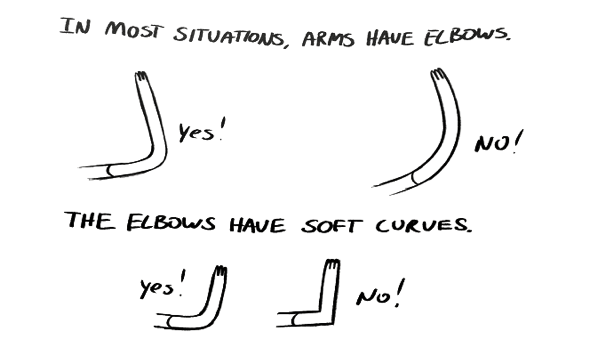One of my favorite tactics to improve students’ understanding is to bust out a terrible non-example. Often, seeing a very bad version of something helps us see why, exactly, that great example is so great!
In other words, good examples are necessary, but not sufficient. To teach well, you must also demonstrate how to do it wrong!
How NOT To Do A Push-Up
Consider how powerful it is to demonstrate a correct push-up and then show some bad versions. You’ll immediately clear up common mistakes and misunderstandings. Plus, non-examples are super fun to create and deliver. Think of how you’d show a kid how not to do a push-up.
- I’d curve my back all weird.
- I’d only go down half an inch and yell “did it!”
- I’d put my butt way up in the air.
How NOT To Draw An Elbow
Flipping through my Art of Adventure Time book, I was struck by how the artists used examples and non-example to demonstrate the show’s art style.
Here’s how to draw Adventure Time elbows:

Notice how the example and non-example work together to clarify that tiny written explanation. I totally get how to draw an Adventure Time elbow but needed very few words.
Put Your Name on Your Paper!
Here’s a super simple (and hopefully relatable) example. You told your students very clearly where to put their names on their papers, but some kids are still writing their names all over the place!
- Tell the class to always put their names on the top right corner of the paper.
- Demonstrate with an example. Post the example on the wall.
- BUT THEN: show them a wrong way to do it. Bonus if this is a silly example (name on the back, upside down on the bottom, etc). Now post the non-example on your wall.
- Bonus: Ask for some silly non-examples from the class: write it backward, write in a spiral, use a yellow crayon.
- Pair that one perfect example with three stinkers.
Of course, come back to that example in the end to highlight the right way, but think about how memorable and clear your instruction has become.
Teaching
It’s the same when teaching any other topic. If we only show students the “great example,” they won’t understand why it’s great. Accompany those exemplars with a terrible non-example.
- Want to improve writing? Intentionally write a bad example to highlight common patterns.
- Want to emphasize how writing out the steps can help to solve equations correctly? Also demonstrate how a short-cut can lead to a disaster.
- Want higher-quality final products? Create a terrible version that shows students what not to do.
- Want better presentations? Give a really bad presentation and contrast it with a high quality version.
- Want to improve study habits? Contrast a great study environment with a distracting one.
These non-examples are quick, they’re super fun to create, and they really help those students who simply don’t understand why a good example is good.
Raise The Roof & The Floor
If a high-quality example raises the ceiling of what students see is possible, the non-example raises the floor. Great examples give successful students something to aim for and non-examples give an extra scaffold for struggling students.
Is there something your students keep doing (or keep not doing) year after frustrating year? This is the perfect chance to bring in a non-example to enhance your explanation.
